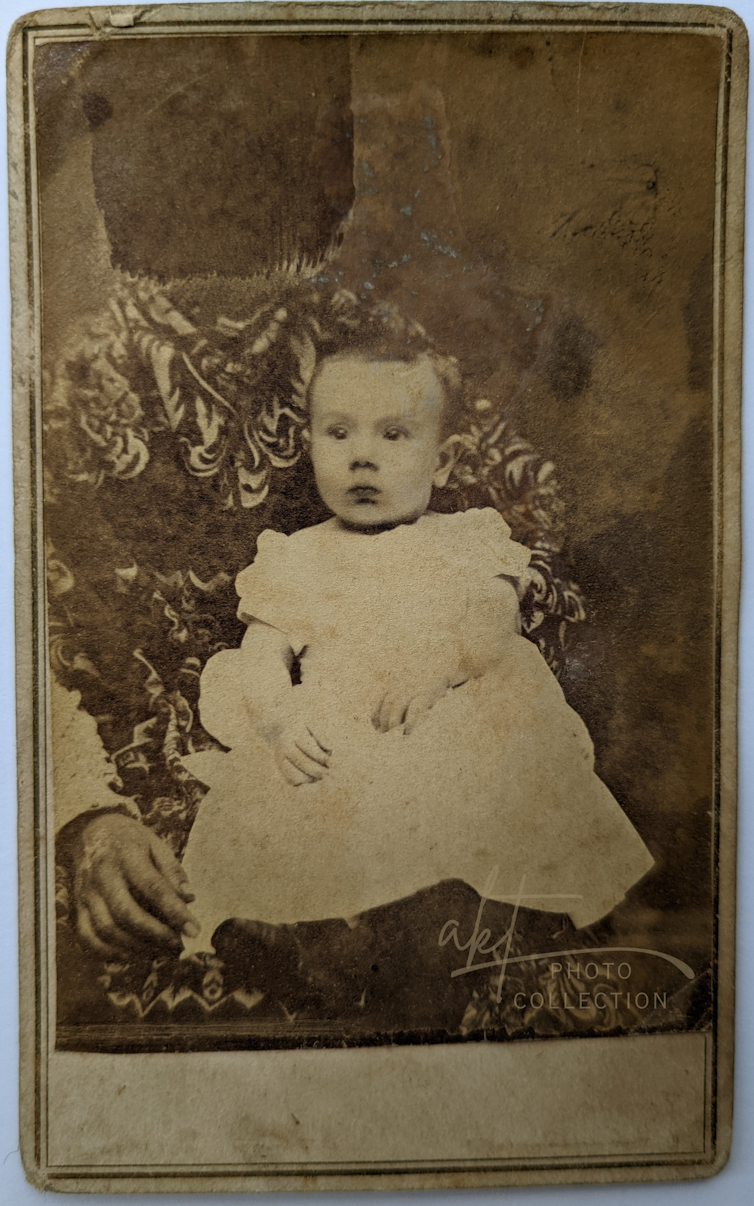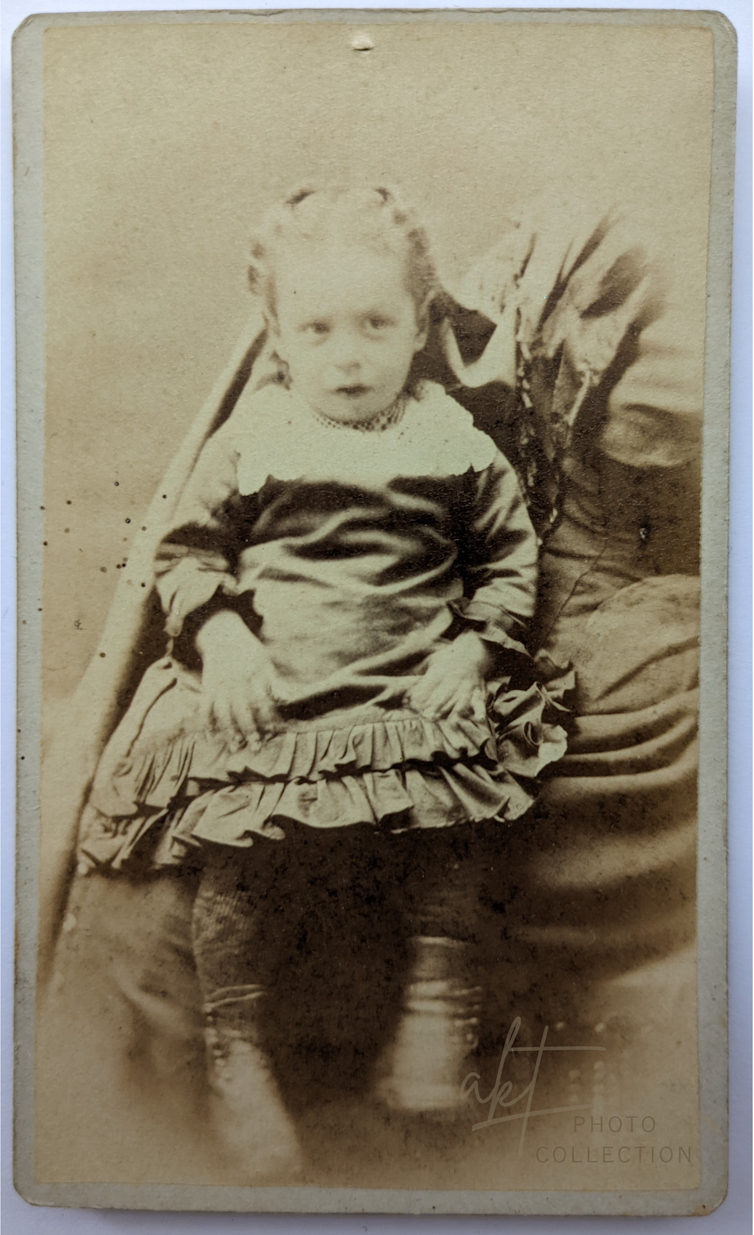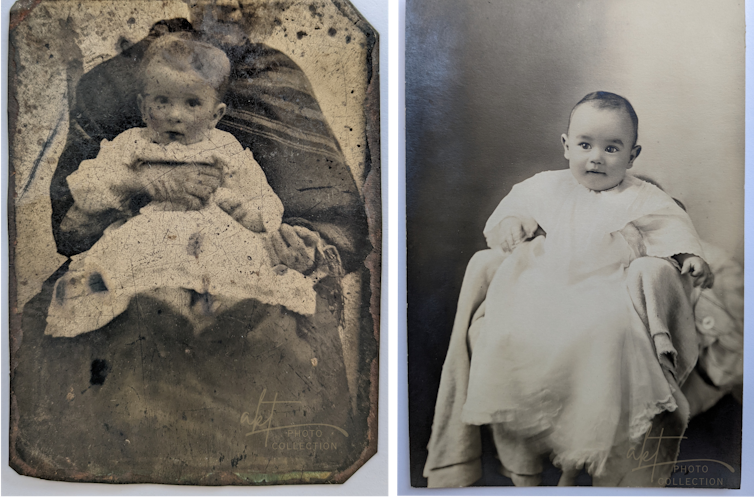Collectors relish so-called “hidden mother photographs” as historical oddities.
These 19th-century images contain very young children held still by half-obscured adults who crouch behind chairs or lurk at the margins of pictures, their protective arms stabilizing babies. The heads and shoulders of the adults are sometimes draped in textiles or summarily cut off, or their bodies are partially tucked behind decorative mats that frame the centered child.
The startling realization that Victorian infants were not reclining on cozy blankets but on comfortable laps fuels breathless online attention. Eager resellers of flea-market finds advertise hidden mother photographs using terms like “spooky wonderful,” “cutie creepy” and “bizarre.” Articles about them tend to imply a treasure hunt for hiddenness – for adult knees or noses, poised hands, bosoms, hat brims and skirts.
But this common framing reduces their cultural importance to sensationalism: Look at how kooky our ancestors were!

As someone who has studied the history of these photos, I find myself drawing an unlikely connection between these stiff, sepia portraits and modern candid snapshots of mischievous children delighting their adoring mothers. Both are part of the tradition of sentimental image-making that surrounds the iconic figure of mother and child.
Exposure times in 19th-century photography were very long by current standards – 20 to 60 seconds – which helps explain why trusted adults were needed to soothe infant subjects into the stillness necessary to take a portrait. But this technological limitation doesn’t explain why their mothers were half-erased from these photos, which has led scholars to argue that Victorian women were effaced by their culture, and casual viewers to assume that the photographers who produced these visual gaffes were hilariously bad at their craft.
But my research has shown that Victorian photographers were documenting children at a moment of widespread desire to focus cultural attention – and therefore camera lenses – on childhood as a precious time that ought to be protected. And the partial obfuscation of mothers was not inconsistent with images of beloved children, because to cherish is to hold.
These are, in short, images of care.

Evolving photographic forms
Photography was a new technology in the 19th century. Early photographers coated thin metal plates with light-sensitive material, exposed them behind the camera’s lens and developed the plates through precise chemical processes. Each exposure yielded a unique and unreproducible picture directly on the metal.
The fragile daguerreotypes of the early 1840s launched a period of constant experimentation. Photographers eventually perfected sturdier tintypes – also unreproducible images on metal plates – and later revolutionized the medium with glass negatives that enabled multiple prints of the same image. These prints required special paper made light sensitive with a coating of ammonium chloride stabilized in albumen, or egg white. With this process, photography became widely viable as a profession, a hobby and an art. In the 1880s, at the height of its production, the Dresden Albumenizing Company required 60,000 eggs a day to meet worldwide demand for its high-quality photographic paper.
Comparing an 1860s tintype with an 1890s gelatin silver studio print shows the evolution of photographic processes.

The studio portrait is characterized by crisp focus, strong contrast between lights and darks, beautiful mid-tones to contour the baby’s cheek, and artful studio lighting to capture alert infant eyes and the gleam of a mother’s cuff button. The tintype is its opposite in every aspect: Its flattened quality and narrower tonal range are hallmarks of this less technically advanced photographic process.
But in both portraits, the sturdy hands of the loving mother stabilize the child.
Picturing tender connections
Scholars don’t know who was first to use the term hidden mother, although some think it emerged around 2008. A photography exhibit at the Venice Biennale by Linda Fregni Nagler and a lyric photo essay by Laura Larson, both published in 2013 and titled “Hidden Mother,” cemented the moniker, which ironically erases the children who are the focal point of these portraits.
One baby picture in particular – a tintype from the 1850s – tells a story about the development of photographic technology and its role in documenting the fleeting, tender moments of childhood.

The baby’s softness is enhanced by comparison with her mother’s strong jawline. The child’s contemplative gaze suggests deep comfort, snuggled as she is against her mother’s side. The contrast between soft and sharp focus is not just one of emotion but the effect of the little one’s slight movement during the necessarily long exposure time.
The baby’s placidity is partly attributable to the presence of a third figure in this photo. This child appears to be a twin: One of her tiny hands is covered protectively by another, equally small, at the end of another arm clad in an identical dress with braided trim. Grounded in their mother’s lap, these babies exist in a triangulated embrace that memorializes the intimacy of family connections.
Putting the original mat, with its oval cutout, back on the photo makes the baby seem to float, removing the embraces that support her. It also suggests where the moniker for these images, hidden mother, came from. But hands, bodies and the power of touch are central to such images.
Valuing the mother-child bond
Modern viewers often assume that 19th-century customs consigned mothering to the margins. But I argue that this is a projection of ahistorical ideas.
It is a strikingly modern tendency to celebrate women’s ability to have both children and careers, without accounting for how one person will then manage two full-time jobs. Such celebration obscures the labor and time parenting requires in favor of the platitude that if we do what we love, for those we love, it is not work.
Contemporary biases, I suggest, may hide mothers far more than did 19th-century portrait conventions. These images remind thoughtful viewers that babies are held and nursed, soothed and protected, nurtured and guided into independence not by abstract notions of being the right kind of mother, not by oddities, but by embodied human beings.
The historical phenomenon of hidden mothers might be productively renamed “cherished child photographs.” This label more accurately identifies their child subjects and centers the relationship, the cherishing, that is at their heart. It also offers a fruitful avenue for tender contemplation of mothers, children, and the myriad forms of motherwork and bodies who perform them, on Mother’s Day and beyond.

